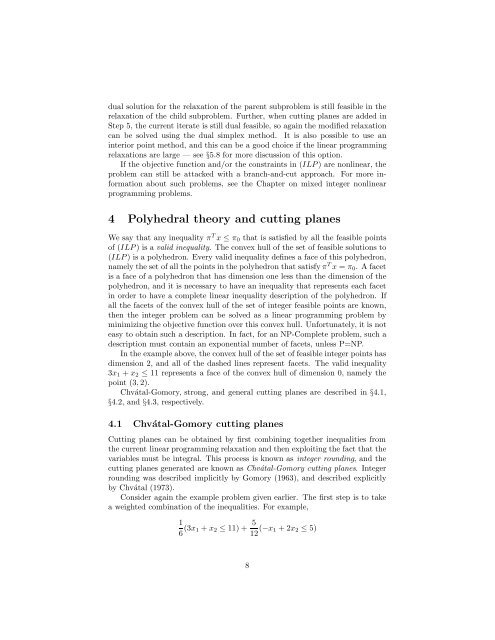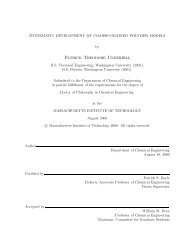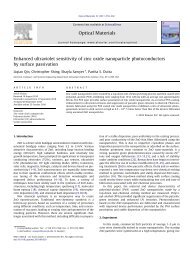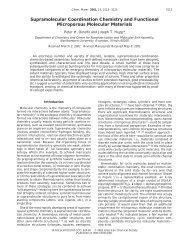Branch-and-Cut Algorithms for Combinatorial Optimization ...
Branch-and-Cut Algorithms for Combinatorial Optimization ...
Branch-and-Cut Algorithms for Combinatorial Optimization ...
You also want an ePaper? Increase the reach of your titles
YUMPU automatically turns print PDFs into web optimized ePapers that Google loves.
dual solution <strong>for</strong> the relaxation of the parent subproblem is still feasible in the<br />
relaxation of the child subproblem. Further, when cutting planes are added in<br />
Step 5, the current iterate is still dual feasible, so again the modified relaxation<br />
can be solved using the dual simplex method. It is also possible to use an<br />
interior point method, <strong>and</strong> this can be a good choice if the linear programming<br />
relaxations are large — see §5.8 <strong>for</strong> more discussion of this option.<br />
If the objective function <strong>and</strong>/or the constraints in (ILP) are nonlinear, the<br />
problem can still be attacked with a branch-<strong>and</strong>-cut approach. For more in<strong>for</strong>mation<br />
about such problems, see the Chapter on mixed integer nonlinear<br />
programming problems.<br />
4 Polyhedral theory <strong>and</strong> cutting planes<br />
We say that any inequality π T x ≤ π0 that is satisfied by all the feasible points<br />
of (ILP)isavalid inequality. The convex hull of the set of feasible solutions to<br />
(ILP) is a polyhedron. Every valid inequality defines a face of this polyhedron,<br />
namely the set of all the points in the polyhedron that satisfy π T x = π0. A facet<br />
is a face of a polyhedron that has dimension one less than the dimension of the<br />
polyhedron, <strong>and</strong> it is necessary to have an inequality that represents each facet<br />
in order to have a complete linear inequality description of the polyhedron. If<br />
all the facets of the convex hull of the set of integer feasible points are known,<br />
then the integer problem can be solved as a linear programming problem by<br />
minimizing the objective function over this convex hull. Un<strong>for</strong>tunately, it is not<br />
easy to obtain such a description. In fact, <strong>for</strong> an NP-Complete problem, such a<br />
description must contain an exponential number of facets, unless P=NP.<br />
In the example above, the convex hull of the set of feasible integer points has<br />
dimension 2, <strong>and</strong> all of the dashed lines represent facets. The valid inequality<br />
3x1 + x2 ≤ 11 represents a face of the convex hull of dimension 0, namely the<br />
point (3, 2).<br />
Chvátal-Gomory, strong, <strong>and</strong> general cutting planes are described in §4.1,<br />
§4.2, <strong>and</strong> §4.3, respectively.<br />
4.1 Chvátal-Gomory cutting planes<br />
<strong>Cut</strong>ting planes can be obtained by first combining together inequalities from<br />
the current linear programming relaxation <strong>and</strong> then exploiting the fact that the<br />
variables must be integral. This process is known as integer rounding, <strong>and</strong>the<br />
cutting planes generated are known as Chvátal-Gomory cutting planes. Integer<br />
rounding was described implicitly by Gomory (1963), <strong>and</strong> described explicitly<br />
by Chvátal (1973).<br />
Consider again the example problem given earlier. The first step is to take<br />
a weighted combination of the inequalities. For example,<br />
1<br />
6 (3x1 + x2 ≤ 11) + 5<br />
12 (−x1 +2x2 ≤ 5)<br />
8







